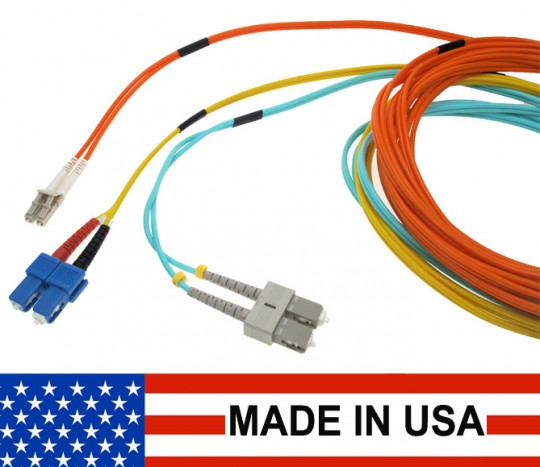The basic definition of patch cables means an electronic cable which connects electronic devices. It allows the transmission of data between them. There are different types of patch cables in the market with fiber optic patch cables being one of the types. Other types include microphone, headphones, RCA, and ethernet.
Fiber optic patch cable, cord or often known as optical jumper, is a fiber cable terminated with fiber optic connectors (LC, SC, MTRJ, ST, and more) at each of their ends. These connectors allow the cord to stay connected to an optical switch or other computing devices. These cords are ideal for indoor use in server rooms, data centers, medical imaging, mechanical engineering, LAN applications, Cable TV networks, Telephone lines, and more.
If you are looking to buy fiber optic jumper for your system, first you should be aware of its types and functionalities. And then choose according to your requirements.
Let’s dive in!
Armored Fiber Patch Cord: It is stronger than the standard fiber patch cord containing all its features. Armored fiber patch cord is resistant to adults’ stepping and is anti-rodents. It is as flexible as a standard fiber optic patch cord.
Bend Insensitive Fiber Patch Cord: It is resistant to bend related damages. It contains a small cable bending radius and prevents additional bend damages by its inventive core design. And also because of its low macro-bending sensitivity. It supports data center, FTTH applications, and high-density cabling that have to be wrapped and adjusted in the tight corners.
Mode Conditioning Fiber Patch Cord: It is a duplex multimode fiber patch cord which has a small length of single mode fiber at the starting point of the transmission length. It is to solve technical issues involved when using single-mode equipment on the existing multimode cable plant. This type of cables’ major aim is to drive the distance of installed fiber plant beyond its original applications as well as to improve data signal quality.
Low Insertion Loss Fiber Patch Cable: It looks similar to common patch cable by its appearance. But its connectors at the ends contain relatively less insertion loss.
Uniboot Fiber Patch Cord: These cords terminate with specially designed LC uniboot connectors. This fiber patch cable unites two fiber in a single cable which delivers high better performance in the high-density cabling environment. It cuts down the cable count up to 50%. It represents the best fit for places where there’s a scarcity of place.
Switchable Fiber Patch Cord: It enables fast polarity change in the field without needing special tools or training. With a compact design, switchable fiber patch cord attributes to more efficient cable management in high-density environment.
And Here’s How To Choose The Right Fiber Optic Jumper:
Step 1: Choose The Right Connector Type
The ends of fiber optic patch cord contain different connectors including LC, SC, ST, FC, MPO, and MTP. Kindly note that these connectors are for different devices. If you want to connect similar ports type devices, use connectors with the same type of connectors on both ends such as LC-LC, SC-SC, MPO-MPO. If you want to connect different ports type devices, LC-SC, LC-ST, LC-FC cables might help.
Step 2: Consider The Mode
These patches are available in two types of modes: Single-mode and multimode. Single-mode patch cables are ideal for long-distance data transmission. If you are looking for relatively shorter distances, multimode fiber optic patch cord could be an ideal choice.
Step 3: Simplex Or Duplex Cable?
Simplex means the fiber patch cable contains a single strand of glass or plastic fiber. It is generally used where only a single receive or transmit line is required between devices. Duplex means two fiber patch cables put side by side for common transceivers. Duplex cable type contains two strands of glass or plastic in comparison with the simplex cable.
Step 4: The Right Cable Length
These cables come in different length. Starting from 0.5m to 50m. It is of utmost importance to choose an appropriate length according to the distance between the devices you wish to connect.
Step 5: Connector Polish Type
There are two connectors available. APC and UPC. APC connectors are suitable for applications like FTTx, passive optical network and wavelength-division multiplexing. However, it is more expensive than UPC connector. For less sensitive digital system, UPC connects would be ideal.
Step 6: Choose The Cable Jacket Type
There are three jacket types: Polyvinyl chloride, Low smoke zero halogen, and Optical fiber nonconductive plenum.
- PVC is ideal for horizontal runs from the wiring center.
- LSZH is good to use between floors in commercial or residential buildings.
- OFNP is good for vertical runs between floors and other applications.
Fiber products offer a wide selection of fiber optic jumpers with a variety of connectors, length, and cable types. The main thing is to consider your key requirement and choose the correct cable according to that to make the most out of it.
Do not consider fiber optic patch cables with normal cables. Here’s what you need to know about fiber optic patch cables to select the right one for you.
If you found this blog post useful, here are some other blog posts that may be of interest.
Know the Right Time to Adopt Fiber Optic Technology
Fiber Optic Cables Vs Ethernet Cables: What Is the Difference?
Fiber Optic Cables and Their Multiple Benefits!

 Log in with Facebook
Log in with Facebook 








